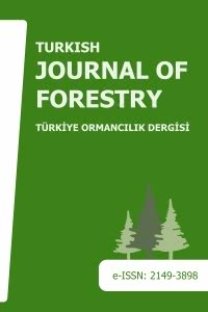Atık muz kabuğu, biber sapı ve kızılçam odun unu kullanılarak biyoplastik kompozit üretimi
Muz kabuğu, Kızılçam, Biber sapı, Biyoplastik
Production of wood-based eco-friendly bioplastic composites using waste banana peel, pepper stalk and red pine wood flour
Banana peel, Red pine, Pepper stem, Bioplastic,
___
- ASTM D 792, 2004. Density and Specific Gravity (Relative Density) of Plastics by Displacement, ASTM International, West Conshohocken, PA.
- Astuiti, P., Erprihana, A.A., 2014. Antimicrobial edible film from banana peels as food packaging. American Journal of Oil and Chemical Technologies, 2.2, 65-70.
- Agustin, M.B., Ahmmad, B., Alonzo, S.M.M., Patriana, F.M., 2014. Bioplastic based on starch and cellulose nanocrystals from rice straw. Journal of Reinforced Plastics and Composites, 33, 2205-2213.
- Bilgin, S., Ertekin, C., Kürklü, A., 2014. Alternatif yakıt olarak sera bitki atığı briketlerinin yakılması ve baca gazı emisyon değerlerinin belirlenmesi. Akdeniz Üniversitesi Ziraat Fakültesi Dergisi, 26 1, 11-17.
- Bof, M.J., Bordagaray, V.C., Locaso, D.E., García, M.J., 2015. Chitosan molecular weight effect on starch-composite film properties. Food Hydrocoll, 51: 281-294.
- Gontard, N., Guilbert, S., Cuq, J.L., 1992. Edible wheat gluten films: influence of the main process variables on film properties using response surface methodology. Journal of Food Science, 57, 190–195.
- Guntekin, E.,Uner, B., Sahin, H.T., Karakus, B., 2008. Pepper stalks (Capsicum annuum) as raw material for particleboard Manufacturing. Journal of Applied Sciences, 8(12): 2333-2336.
- Pan, D.D., Jane, J.L., 2000. Internal structure of normal maize star-ch granules revealed by chemical surface gelatinization. Biomacromolecules, 1: 126–132.
- Šprajcar, M., Horvat, P., Kržan, A., 2012. Biopolymers and Bioplastics: Plastics Aligned with Nature: National Institute of Chemistry.
- Soltani, M., Alimardani, R., Omid, M., 2010. Prediction of banana quality during ripening stage using capacitance sensing system. Australian Journal of Crop Science, 46, 443-447.
- Özdemir, F., Ramazanoğlu, D., 2019. Farklı biyokütlelerden elde edilen nişasta ile akıllı biyoplastik malzeme ve odun biyoplastik kompozit üretimi. Bartın Orman Fakültesi Dergisi, 21(2): 377-385.
- Özdemir, F., Ramazanoğlu, D., 2018. Nişasta esaslı dilatant sıvıların akıllı darbe absorban malzemesi olarak kullanılabilirliğinin araştırılması. 3. Uluslararası Akdeniz Bilim ve Mühendislik Kongresi, 24-26 Ekim 2018, Çukurova Üniversitesi, Kongre Merkezi, Adana,Türkiye, 1054.
- Qin, Y., Yang, J., Xue, J., 2015. Characterization of antimicrobial poly (lactic acid)/poly (trimethylene carbonate) films with cinnamaldehyde. Journal of Materials Science, 50, 1150-1158.
- Whistler, R.L., BeMiller, J.N.,1996. Starch carbohydrate chemistry for food scientists. St. Paul, MN: Eagan Press, USA, 117–151.
- ISSN: 1302-7085
- Yayın Aralığı: Yılda 2 Sayı
- Başlangıç: 2000
Su itici maddeler ile kombine edilmiş bakırlı ve borlu bileşiklerin yıkanma özellikleri
Orhan GULSEVEN, Sezgin AYAN, Halil Barış ÖZEL, Esra Nurten YER
AB Su Çerçeve Direktifinin Türkiye’de su kaynakları yönetimine etkisi
Atık muz kabuğu, biber sapı ve kızılçam odun unu kullanılarak biyoplastik kompozit üretimi
Ferhat ÖZDEMİR, Doğu RAMAZANOĞLU
Eğirdir yöresi kızılçam meşcereleri için ağaç hacim denklemlerinin karşılaştırılması
Ramazan ÖZÇELİK, Hakkı ALTINKAYA
Türkiye'de leylek (Ciconia ciconia Linnaeus, 1758) dağılımının iklim değişikliğine göre kestirimi
Korgan (Ordu) yöresinde doğal yayılış gösteren bitki taksonlarının etnobotanik özellikleri
Ayşe Gül SARIKAYA, Asiye KARAEVLİ
Ormancılık işlerine yönelik bir zaman ölçme ve kaydetme aracının geliştirilmesi
Orman işletme şeflerinin performanslarına yönelik nitel bir çözümleme (Batı Akdeniz Bölgesi örneği)
Ersin YILMAZ, İsmet DAŞDEMİR, Mehmet ERPULAT, Süleyman ALKAN, Kader Hale GÜLER
